The Best Exercises for Posture Correction

You may have heard the modern expression, “Sitting in the new smoking”. While albeit, it may be a slight exaggeration, anything that puts your body in a stationary position for too long is not good for it. As a physical therapist, I’ve seen all complaints of pain from the neck to the pelvis and throughout the extremities. Of course pain or an injury can occur because of trauma or blunt force, however, a high percentage of non-emergency related injuries typically occur due to the fact that one has incorrect posture. Poor posture can lead to mal-alignment, which then creates impingement to a muscle, tendon, or nerve, resulting in repetitive wear and tear, inflammation, pain, and ultimately decreased efficiency of muscle activation. Sorry to inform you runners, but doing 20 or 100 miles a week won’t save you.
If you have a desk job, standing job, are homemaker or caretaker, it doesn’t matter what your personal, recreational, or professional life entails, if you are not doing any additional strength training for your core and posture, you can bet that somewhere along the line poor posture can wreak havoc on, not only your running form and efficiency but eventually your day to day activities as well.
First, why is posture important?
Our skeletal structure, when looking from the side, mimics an “S” shape. This shape allows us to maintain upright against gravity by equally distributing the forces from it and our own body weight. The spine is a protective structure allowing us to send connections to and from our brain back and forth to the rest of our body. Additional benefits of our spines also allow us to also visually see in front of us, breathe properly, sit, stand, squat, run, lift and carry. Really any function you can think of starts with the stabilization of the spine. It is our powerhouse and internal structural beams for stability before movement. Think of the spine as being similar to the purpose of a foundation of a home, it is meant to hold everything up and together.
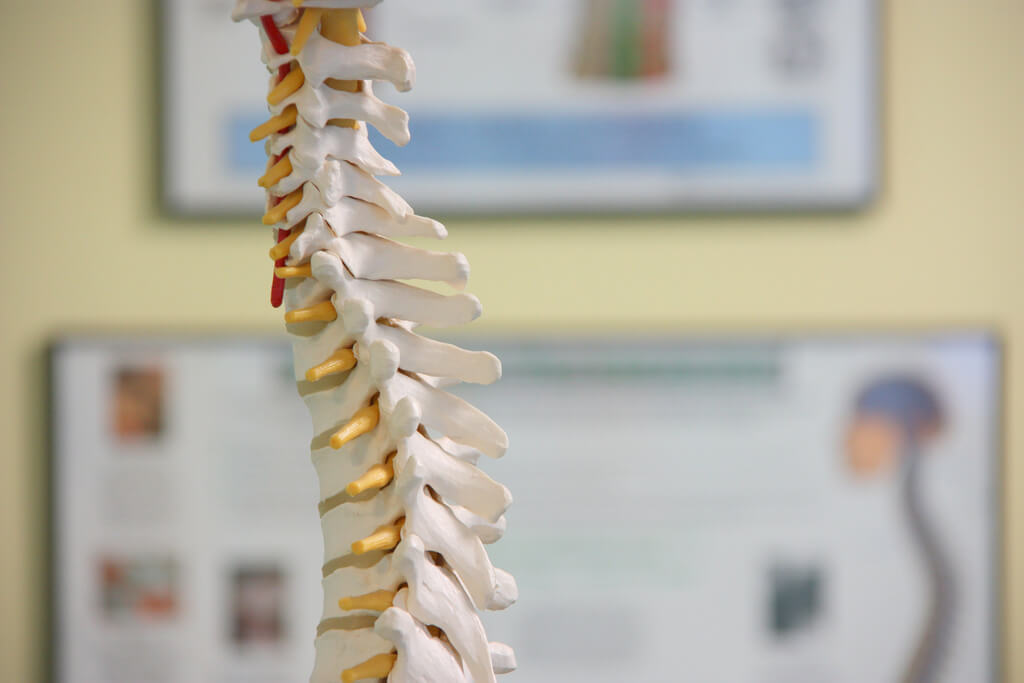
If you have been neglecting your posture, alas, there is hope! Here are my top 10 favorite posture correction exercises that should be incorporated at least 2-3 times a week (or heck, why not every day!) that can be done in conjunction with a running program. Even if you aren’t currently training for a race or you are doing core and strengthening exercises take a gander at these simple ones.
On a side note, if you are already experiencing pain or discomfort before starting this program, I suggest taking the time to seek out a healthcare professional, like a physical therapist, to assess your individual issue and create a personalized program.
Posture Correction Exercises
Transverse Abdominal Activation
The Transverse Abdominal can be thought of as an internal back brace. It attaches to your lower half of the spine and wraps around the internal organs. It is the deepest layer of abdominal muscles and should initiate to stabilize the spine prior to and during movement. It is often a neglected muscle and if it is not properly firing, can create shearing forces typically in the low back causing irritation and maybe worse symptoms.
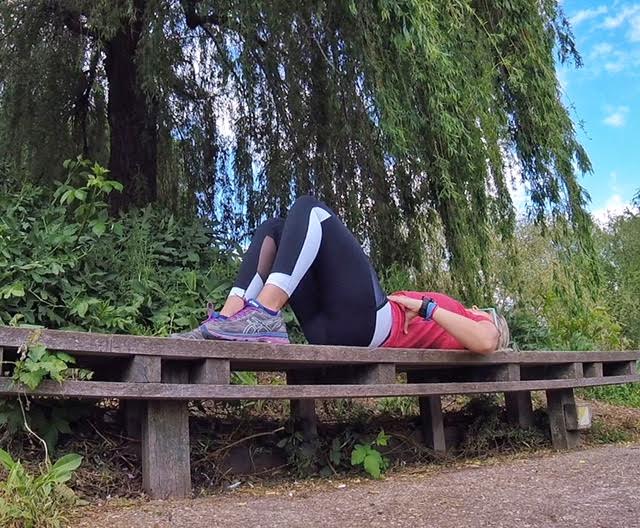
To activate lay flat on back with knees bent. This position with help you activate the muscle easier as gravity will assist you. I always tell my patients to envision if someone were to lightly punch your gut, contract your abdominal wall to protect your organs from the punch without tilting the pelvis or lifting the head, and all while breathing. Give a hold for 5 seconds and repeat 10 times.
Bridge
A bridge will target your glutes and help improve hip extension and lumbar stabilization. Strong glutes help maintain a neutral pelvis which in turn protects our low back. Strong glutes also improve push off in running and navigating hills.
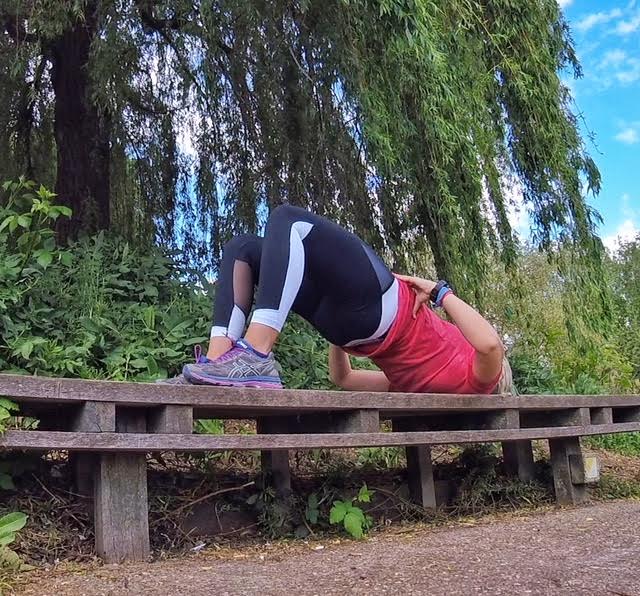
Begin on your back with both knees bent and feet placed on ground hip-width apart. Engage the abs (remember the punch) and slowly lift the buttocks off the ground to raise pelvis towards the sky. Hold for 5 seconds at the top and slowly lower back down. Repeat 10 times.
Low Lunge with Twist
This stretch opens everything with its primary focus on thoracic rotation and hip flexion mobility. Known by some as the world’s greatest stretch. Go ahead and give it a whirl.
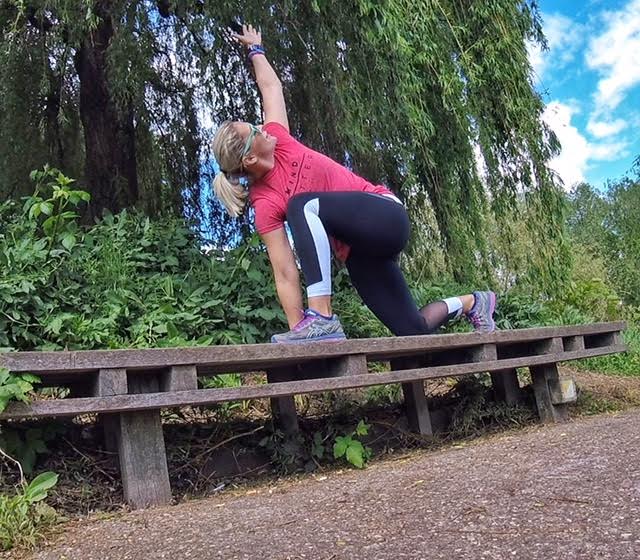
Start in a high plank position. Bring one foot up between your hands while lowering the knee of the back leg. Place the opposite hand on the inside of the front foot while twisting the other hand up towards the sky. Hold for 10-15 seconds and repeat a couple times on each leg.
Bird/Dog
This exercise challenges the core against gravity. We then throw in a diagonal stabilization activation pattern. This fires everything from shoulder to hip stabilizers.
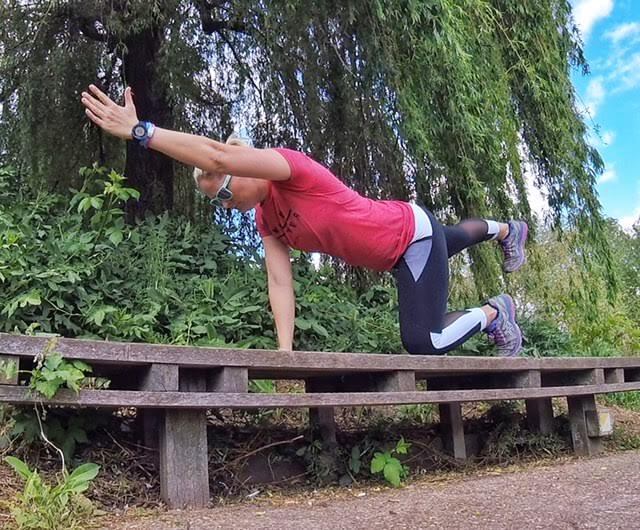
Start on hands and knees. Engage the abs to prevent a sway back. Start extending one arm and opposite leg, reaching in front and behind you while maintaining a neutral pelvis. Hold for 5 seconds then repeat on the other side. Repeat 10 times.
Thoracic Rotation
The thoracic spine is the middle part of your spine just below the neck and just above the low back. It connects to your ribs and the primary motion is rotation. This motion is important for functional tasks like driving, looking behind you and in sports. For running this motion improves arm swing.
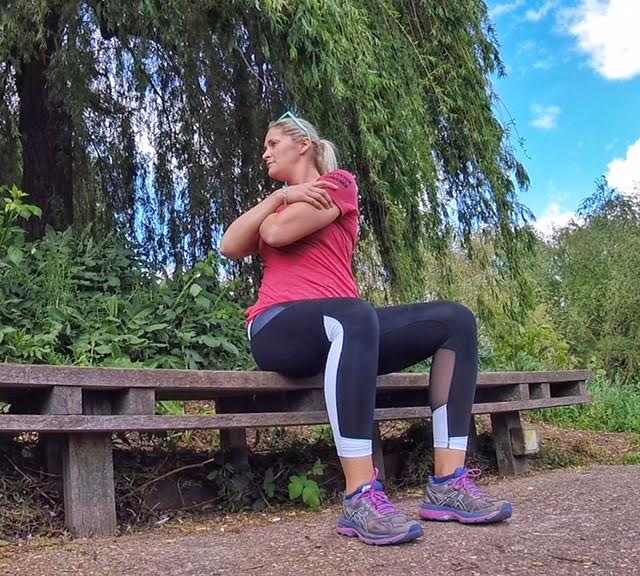
Take a seat and cross arms in front of your chest. Inhale to sit up tall and while exhaling, twist the trunk to the right as far as you comfortably can. Hold for 5 seconds. Repeat to the other side, doing each side 3 times.
Wall Assisted Arm Slides
This exercise promotes a neutral spine, scapular movement, and acts as a chest opener. This reduces rounded shoulders found to often when using a computer or cell phone and can disrupt breathing patterns.
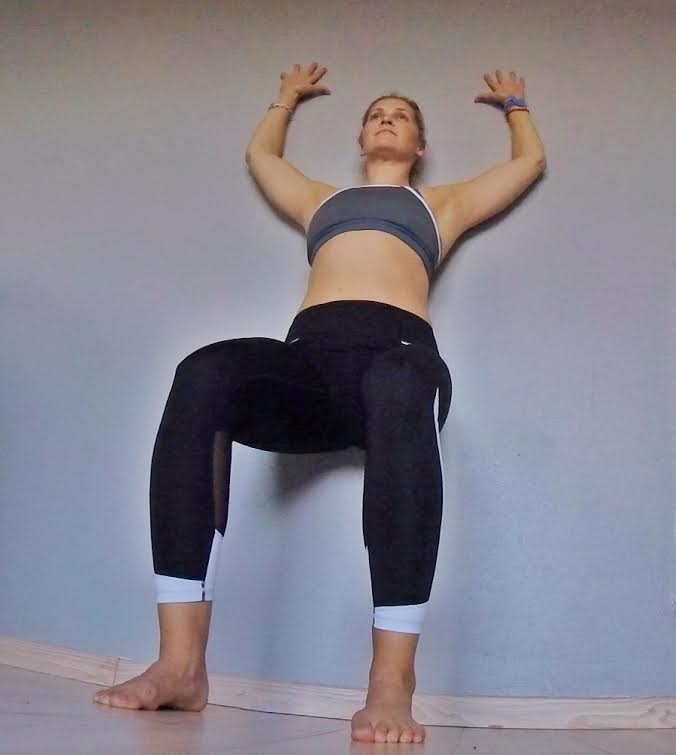
Lean up against a wall in a mini squat position. Find a neutral spine with head and pelvis aligned up against the wall. Raise your arms to a field goal position, attempting to make contact with wrists and elbows without the low back curving too much. Imagine you are doing a snow angel motion as you would in the snow by sliding hands up overhead, maintaining contact at the wrist and elbow, and then glide back down. Repeat 10 times.
Lower Trapezius Activation
The trapezius muscle is a big diamond shaped muscle on the upper back that helps to shrug and retract the shoulders. It is divided into 3 portions: upper, middle and lower which should all work in an equal ratio. However, life throws us curveballs occasionally and this accompanied with stress tends to make us over-activate our upper trapezius more so than the lower. This, in turn, reduces our ability to activate our lower trapezius to help retract and downward rotate our scapulas leading to rounded shoulders anteriorly. Not good.
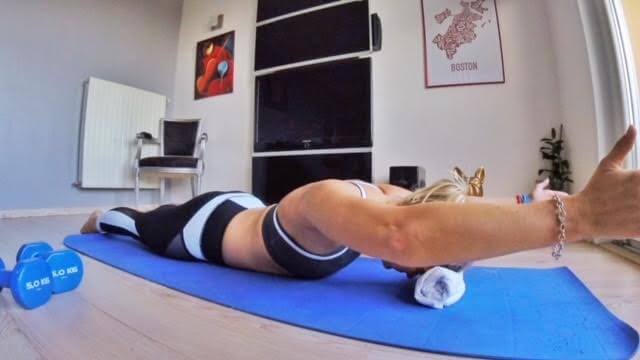
Lay on your stomach with a towel rolled up under forehead so you can breathe. Lengthen the space between your ears and shoulders by drawing your shoulder blades down and back then raise your arms overhead like you are doing the Y in the YMCA. Lift and hover the arms a few inches and hold for 5 seconds. Repeat 10 times.
Thoracic Extension
The thoracic spine is the portion of the back that can round forward when our posture is poor. This leads to forward head and rounded shoulders and can ultimately lead to neck, chest, and shoulder pain along with difficulty in breathing .
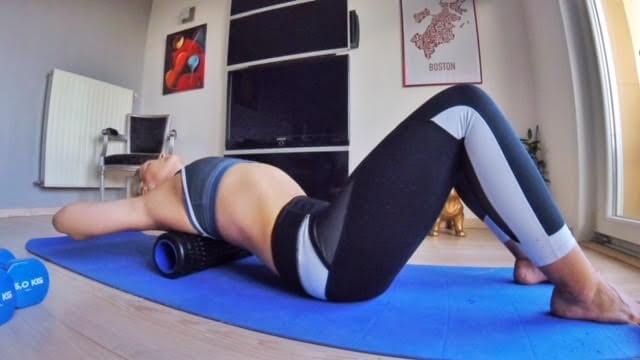
Grab your foam roller and place it perpendicular between your shoulder blades while laying on your back. Place hands under your head to protect neck while slowly rolling up and down to mid-back a few times.
Lats Release
The latissimus dorsi is a big fan-shaped muscle that attaches from our low back, passes under our armpit and attaches to the front of the shoulder. Its main job is shoulder extension and internal rotation, think the action of a pull-up. But if this muscle is overactivated and never stretched or released, it contributes to rounded shoulders and increased low back lordosis.

Place the foam roll under the armpit and tilt the body to a 45-degree angle. Use the weight of your own body to press into the tissue lateral to the shoulder blade and roll up and down the armpit a few times.
Piriformis Release
The piriformis is a hip external rotator that gets aggravated often with a lot of sitting. When this occurs, it can lead to spasm and sometimes sciatica. Time to nip this before it becomes a pain in the butt!
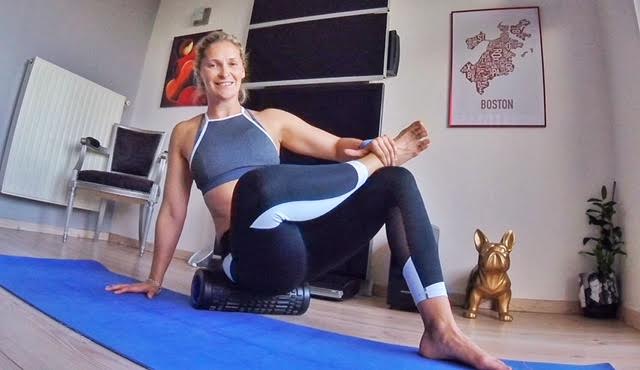
Sit on your foam roller. Place one hand behind you on the floor to maintain balance as you place one foot up on the opposite knee. Lean onto the buttock with the leg that is lifted. Find the hot spots and maintain pressure for 30-60 seconds. Repeat on each side.
I hope you find these tools helpful and discover a world of improved posture and gains in your running form and efficiency.
Latest Articles
 Is Running on a Treadmill Easier Than Running Outside?Runners have their own preferences, whether it is treadmill running, running outside on the road, or exploring trails. So...
Is Running on a Treadmill Easier Than Running Outside?Runners have their own preferences, whether it is treadmill running, running outside on the road, or exploring trails. So... Is It OK to Use Trail Running Shoes on the Road?While trail running shoes can be used on roads, especially in situations where a runner encounters mixed terrains or pref...
Is It OK to Use Trail Running Shoes on the Road?While trail running shoes can be used on roads, especially in situations where a runner encounters mixed terrains or pref... How to Fix Sore Quads After Running?Rest, ice, gentle stretching, and over-the-counter pain relievers can help soothe sore quads after running. Also, ensure ...
How to Fix Sore Quads After Running?Rest, ice, gentle stretching, and over-the-counter pain relievers can help soothe sore quads after running. Also, ensure ... 10 Fruits With The Most Electrolytes to Replace Sports DrinksThese fruits are high in electrolytes such as potassium, magnesium, and calcium, essential for hydration, muscle function...
10 Fruits With The Most Electrolytes to Replace Sports DrinksThese fruits are high in electrolytes such as potassium, magnesium, and calcium, essential for hydration, muscle function...

